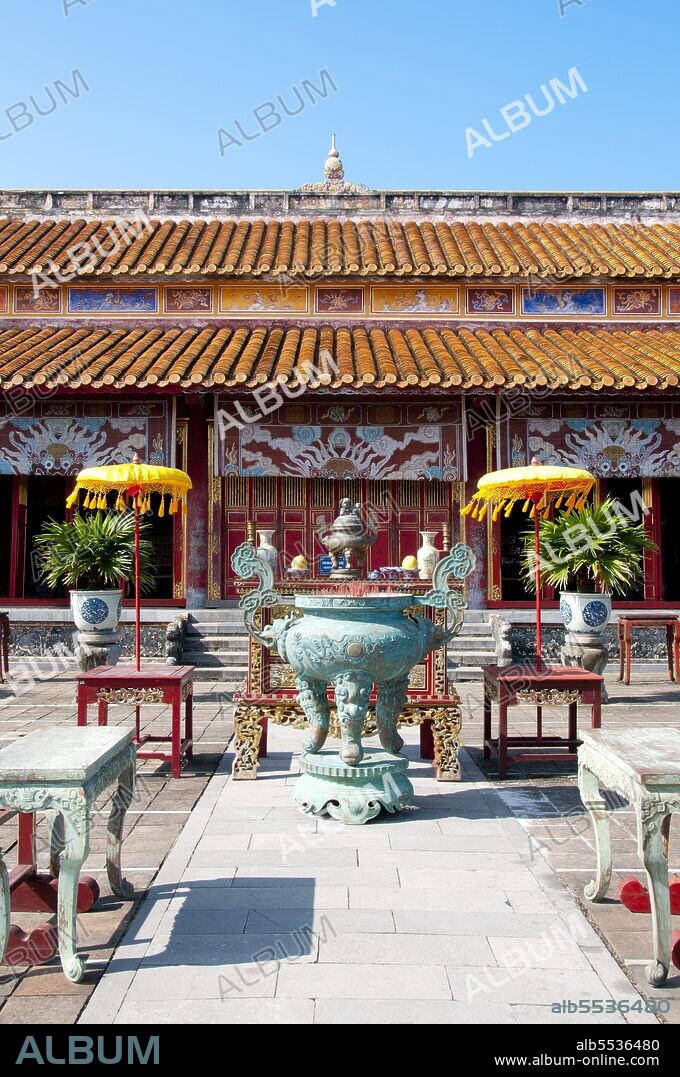alb5536480
Vietnam: Th? Mi? u (The Mieu) ancestral temple, The Imperial City, The Citadel, Hue.

|
Add to another lightbox |
|
Add to another lightbox |



Title:
Vietnam: Th? Mi? u (The Mieu) ancestral temple, The Imperial City, The Citadel, Hue.
Caption:
The Th? Mi?u, also called Th? T? Mi?u, is an ancestral temple and was constructed on the orders of Emperor Minh M?ng in 1822-1823. It honours the emperors of the Nguy?n Dynasty. Nine dynastic urns (Vietnamese c?u d?nh ??) in front of the Th? Mi?u were also cast in 1822 and dedicated to the first nine Nguyen emperors. Emperor Gia Long ordered the construction of Hue Citadel in 1805. The vast complex is built according to the notions of fengshui or Chinese geomancy, but following the military principles of the noted 18th century French military architect Sebastien de Vauban. The result is an unusual and elegant hybrid, a Chinese-style Imperial City carefully aligned with surrounding hills, islands and waterways, but defended by massive brick walls between 6-12 metres high and 2.5 metres thick, punctuated by towers, ramparts, a massive earth glacis, and 24 Vauban-inspired bastions. The entire complex was further protected by wide moats, crossed by gracefully arched stone bridges leading to ten gates, the chief of which is Cua Ngo Mon, the south-east facing ‘Meridian Gate’. To compound the exotic hybrid effect, guard posts designed as Chinese-style miradors, complete with sweeping eaves crowned by imperial dragons, surmounted each gate. Finally, directly in front of the Ngo Mon Gate, a massive brick fort 18 metres high was constructed both as an additional barrier against malign spirits, and as a defensive redoubt. The area within the Citadel - in all, 520 hectares (1300 acres) - comprises three concentric enclosures, the Civic, Imperial and Forbidden Purple Cities. Access is by way of ten fortified gates, each of which is reached by a low, arched stone bridge across the moat. In imperial times a cannon would sound at 5am and 9pm to mark the opening and closing of the gates. Hue was the imperial capital of the Nguyen Dynasty between 1802 and 1945. The tombs of several emperors lie in and around the city and along the Perfume River. Hue is a UNESCO World Heritage Site.
Credit:
Album / David Henley/Pictures from History/Universal Images Group
Releases:
Model: No - Property: No
Rights questions?
Rights questions?
Image size:
3388 x 5100 px | 49.4 MB
Print size:
28.7 x 43.2 cm | 11.3 x 17.0 in (300 dpi)
Keywords:
ADORATION (GENERAL) • ADORATION • ANCESTOR • ANNAM • ARCHITECTURE • ASIA PICTURES • ASIA • ASIAN IMAGE • ASIAN IMAGES • ASIAN PICTURES • ASIAN • CASTLE • CITADEL • CULT • CULTURED • DAVID HENLEY • FORTRESS • HISTORIA UNIVERSAL • HISTORICAL IMAGES • HISTORICAL PICTURES • HISTORICAL • HISTORY IMAGES • HISTORY PICTURES • HISTORY • HU? • HUE • IMPERIAL CITY • IMPERIAL • INDOCHINA • KINH • MIEU, THE • PALACE • PALAZZO • PRAISE • RELIGION • RITUAL • SOCIALIST REPUBLIC OF VIETNAM • TEMPERA • TEMPLE • TEMPLES • TH? MI? U • UNESCO WORLD HERITAGE • VIÊT • VIETNAM • VIETNAMESE • WORSHIP
 Pinterest
Pinterest Twitter
Twitter Facebook
Facebook Copy link
Copy link Email
Email
